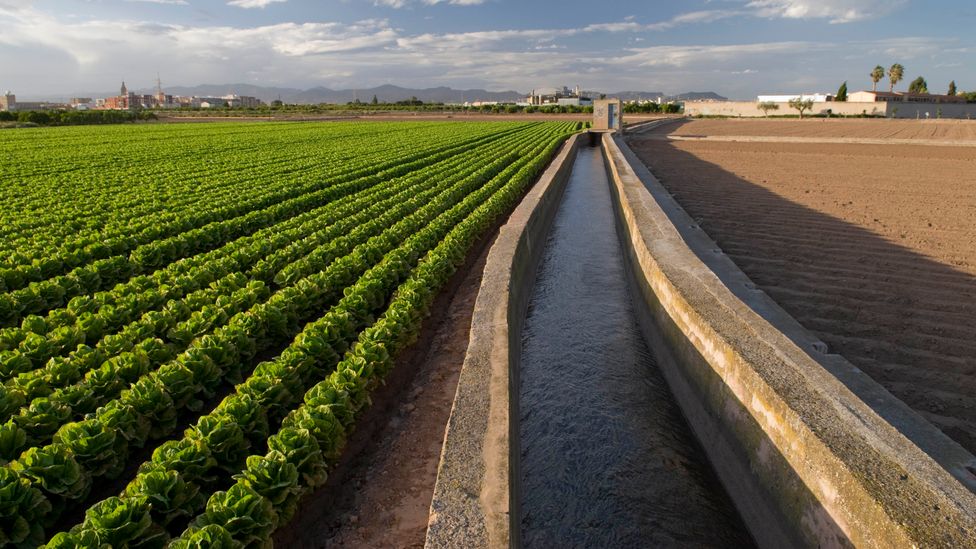
Here is a wonderful demonstration of the application of the wisdom of both state style investment and the application of natural community.
It is all built around a werll designed birrigation system that absorbs water from hte local river over a specific time of the year and distributes that water fairly with a justice system to call in cheaters. someone always has to try.
Now imagine all this applied to every river system on Earth. It is not imposxible. Then do it in support of proper forest management as well.
Spain's Moorish irrigation system.
(Image credit: FAO-GIAHS)
Invented by the region's Moorish rulers 1,200 years ago, Valencia's irrigation system is now a model for sustainable farming.
It's early. Fingers of sunlight are only just starting to creep along the streets of Valencia's Old Town, but the stalls inside the city's Mercado Central are doing a brisk trade already. There's a queue at the charcuterie, and the man behind the counter is slicing wafer-thin strips of jamón serrano in double time. He zips from one customer to the next, ducking between stocky legs of ham that hang from the front of his stall like fatty windchimes. In the seafood section, tuna, sea bream, anchovies and huge pink langoustines glisten in the ice. One stall here specialises in snails; another sells only saffron.
Among them all, taking pride of place at the heart of the Mercado Central, are the fruit and vegetables – plump, richly coloured and all grown in La Huerta (L'Horta in Valencian), a patchwork of neat market gardens that fan out for 28 sq km around the city. Encarna Folgado, owner of Frutas y Verduras Folgado, has been running a stall here for more than 45 years, buying seasonal vegetables direct from the farmers who work in La Huerta's fields. If you need to buy the beans used in a traditional paella Valenciana, you come to Folgado.
"The ferraúra have to have a bright green colour, but not too intense," she tells me, referring to the horseshoe-shaped beans that are almost spilling out of their crate. The rochet, a red and green bean, "has to be a few centimetres wider and thicker, but only a little bit". And as for butterbeans, which I can see bulging through their cases, "the best (ones) to eat are when they begin to turn from yellow to green".
Alongside the beans are spongy heads of broccoli, waxy red peppers, fat garlic bulbs and spring onions the size of truncheons. They're all part of an incredible bounty of produce that is grown in La Huerta each year, despite the fact that its fields enclose Spain's third-largest city. The secret is an ingenious maze of channels, ditches, weirs and floodgates invented by the region's Moorish rulers 1,200 years ago.
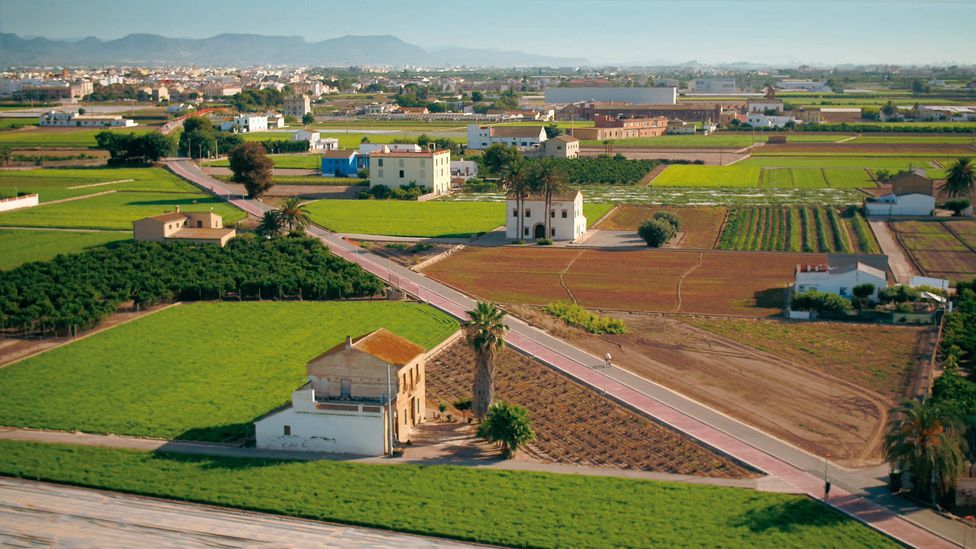
Irrigation canals criss-cross L'Horta and provide the farms with consistent water (Credit: Visit Valencia)
Eight main irrigation channels, or acequías, funnel water from the River Turia, which is then carried – by gravity – along a series of smaller branches, which distribute the water to thousands of tiny plots across the fields. The amount of water each plot receives isn't measured in terms of volume but rather on how well the river is flowing. The unit, known as a fila (from the Arabic word meaning "thread"), represents an individual's right to a proportion of the water over a period of time; the irrigation cycle usually lasts a week, but when the river's level is low, the cycle is extended.
It's an incredibly efficient system. Each plot receives the same access to water for the same amount of time, no matter where they are in the mosaic, and there are no water shortages, even in periods of drought. And the result is an incredibly diverse crop yield. Centuries-old local rice varieties grow in the fields around Lake Albufera, south of the city, while unique species like chufa, or tiger nuts (which are used to make the ice-cold milky Valencian drink of horchata), are sown in the north.
"The system of water management adopted here [means that] aubergines, oranges, artichokes and olive trees can all co-exist together," said Clelia Maria Puzzo of the United Nations' Food & Agriculture Organization (FAO), which added La Huerta to their list of Globally Important Agricultural Heritage Systems (GIAHS) in November 2019. "A variety of crops were imported from Asia and America hundreds of years ago, but they adapted perfectly because of this irrigation system."
The whole process is held together by a unique social organisation that has been governing La Huerta for more than 1,000 years. The Tribunal de las Aguas de la Vega de la València, or Water Court of the Plains of Valencia, was established around 960 CE and as such is officially the world's oldest judicial body. The tribunal is made up of eight farmers, elected representatives of the communities that work off each of the main irrigation channels, who meet to settle disputes outside the doorway of Valencia Cathedral every Thursday at noon.
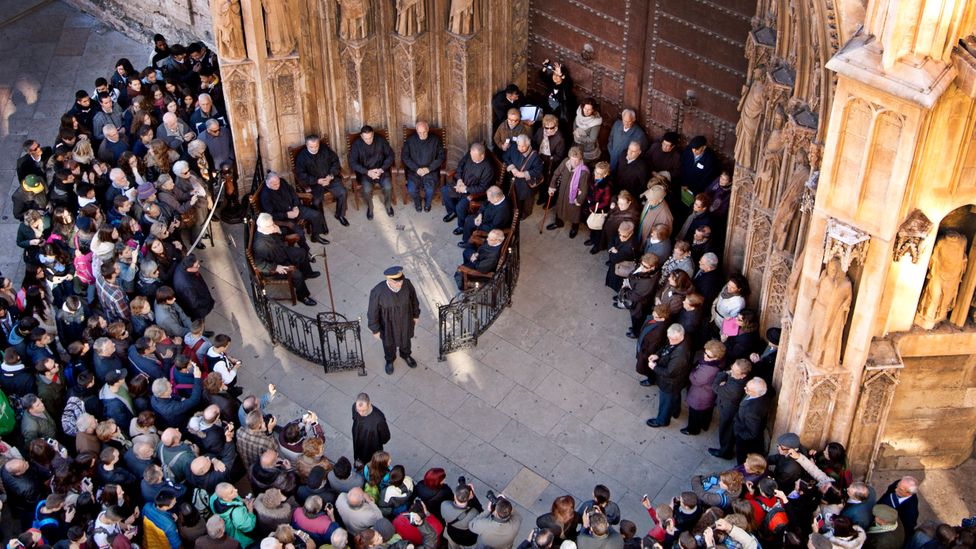
Visitors can watch the meeting of the Tribunal every Thursday at noon outside Valencia Cathedral (Credit: Visit Valencia)
It's quite a sight, with the men – they are all men – dressed in black smocks and seated in a semi-circle of leather-topped wooden chairs, where they enforce the rules of distribution. Water is the only issue up for debate, and according to María José Olmos Rodrigo, the Tribunal's secretary, the defendants are usually hauled before the court because "they've flooded a neighbour's field, taken water out of turn or haven't maintained their section of irrigation ditch correctly". Proceedings are in Valencian and are ruthlessly quick; all decisions are final.
It's trendy to talk about resilience, but this is the history of La Huerta
While the Tribunal has been an ever-present aspect of the system, the use of the land itself has evolved over time. "It's trendy to talk about resilience, but this is the history of La Huerta," said Miquel Minguet, CEO of Horta Viva. "We adapt the crops to the times, we change a lot, very often, just to survive." His company reflects this mentality, moving from farming a small organic garden near Alboraya, north of the city, to organising tomato tastings in La Huerta and running agritours around the region.
This culture of adaptation – in La Huerta's case, an intervention that has not only conserved but remarkably improved the existing conditions, according to FAO’s Puzzo – is seen as a potential sustainable solution to modern farming problems, and since July 2019, Valencia has been home to the World Centre for Sustainable Urban Food (CEMAS), an initiative set up with the aim of ensuring sustainable food for future generations.
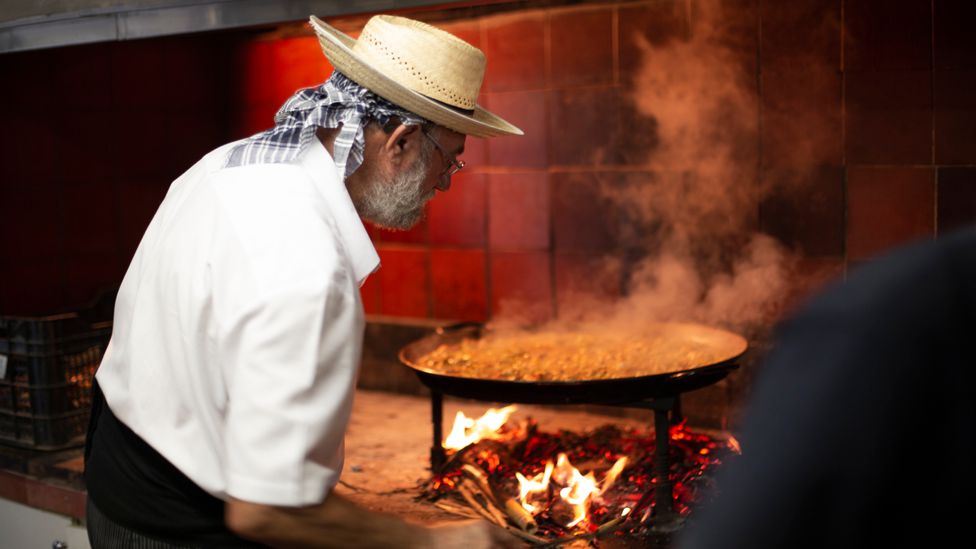
At Tony Montoliu's restaurant, diners can pick their own produce for him to cook (Credit: Visit Valencia)
"Production in La Huerta is basically intended for self-consumption and the local market," said Vicente Domingo, director of CEMAS. "Thanks to its unique structure, it has managed to survive over the centuries with the efforts of generation upon generation of farmers that have preserved this land despite the pressure of urbanisation."
Those farmers include Tony Montoliu, who has worked a plot bordering the town of Meliana, in the north of La Huerta, since he was 12 years old. Montoliu was cultivating crops like okra and Chinese cabbage long before they became popular here and has a history of recovering seeds from species like the cacau del collaret, a highly regarded local peanut. "Life as a farmer is about discovery," he said. "You learn more every day because the field and the land are constantly talking."
Montoliu grows what he needs for his restaurant, a traditional barraca, one of the white-walled, gable-roofed thatched houses that you see dotted among the fields of La Huerta. Diners pick their own vegetables and Montoliu cooks what's required – often as part of a rabbit and chicken paella, his star dish – and then gives them any surplus to take home. It's the epitome of slow food, or "zero metres", as he calls it.
Most farmers, though, sell what they can't eat themselves at the Tira de Comptar, a wholesale market that is almost as old as the Tribunal de Aguas; or to Folgado and the other fruit and vegetable sellers in the Mercado Central, unfailingly furnishing their stalls with spongy heads of broccoli, waxy red peppers and fat garlic bulbs. And horseshoe-shaped ferraura beans – a bright green colour, but not too intense.
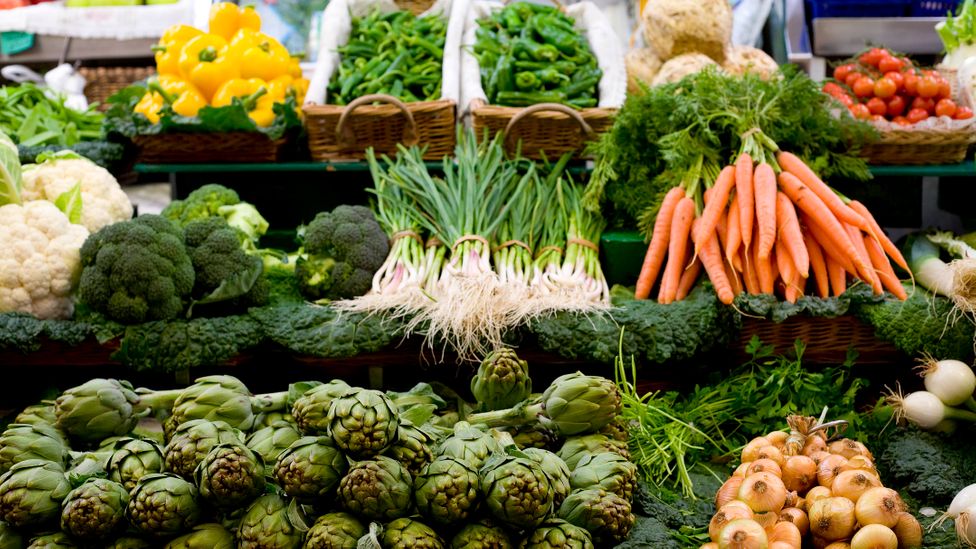
The fruit and vegetables at the Mercado Central are all grown in L'Horta (Credit: Visit Valencia)
Ancient Engineering Marvels is a BBC Travel series that takes inspiration from unique architectural ideas or ingenious constructions built by past civilisations and cultures across the planet.
--
No comments:
Post a Comment